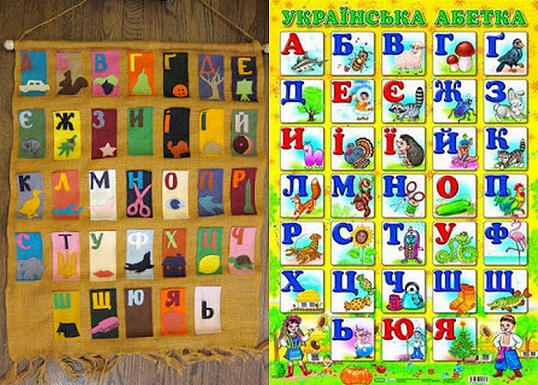There are several differences in the Ukrainian alphabets used in the diaspora (specifically the community that has its origin from Galicia) and in Ukraine, in particular, how the alphabet is called, the pronunciation of the letters, the melody used to sing the alphabet (or the lack thereof a song), as well as a difference that I only recently discovered — the placement of the soft sign.
 In Ukraine the soft sign “ь” doesn’t come at the end of the alphabet as I was taught in the diaspora, but third to last. I was quite shocked to discover this. After researching the history, I learned that in Ukraine the soft sign was moved relatively recently — in 1993. That year the soft sign was moved from the end of the alphabet to the place after the letter “щ” so that the order of the letters would be in line with the Russian alphabet. This was motivated by the need for computer coding of the alphabet (the Ukrainian letters that were absent in the Russian alphabet were placed in the coding table separately, out of the alphabet). Now this argument has lost its relevance, because after the letter “ґ” (g) was returned to the Ukrainian alphabet, the difference between the two alphabets begins from the fifth position. And in any case, it is entirely illogical to have a letter that does not correspond to a separate sound within the alphabet (https://r2u.org.ua/node/140). And so while in Ukraine the soft sign still comes at the end, in the diaspora placement at the end has still been preserved.
In Ukraine the soft sign “ь” doesn’t come at the end of the alphabet as I was taught in the diaspora, but third to last. I was quite shocked to discover this. After researching the history, I learned that in Ukraine the soft sign was moved relatively recently — in 1993. That year the soft sign was moved from the end of the alphabet to the place after the letter “щ” so that the order of the letters would be in line with the Russian alphabet. This was motivated by the need for computer coding of the alphabet (the Ukrainian letters that were absent in the Russian alphabet were placed in the coding table separately, out of the alphabet). Now this argument has lost its relevance, because after the letter “ґ” (g) was returned to the Ukrainian alphabet, the difference between the two alphabets begins from the fifth position. And in any case, it is entirely illogical to have a letter that does not correspond to a separate sound within the alphabet (https://r2u.org.ua/node/140). And so while in Ukraine the soft sign still comes at the end, in the diaspora placement at the end has still been preserved.
As for the other differences, in the diaspora, we usually say “азбука” or “абетка” while in Ukraine it is more common to say “aлфавіт” or “абетка” (for children).
When we (at least my Chicago diaspora community) say or sing the alphabet, we just say the sounds (a, b, v, h, g, d…), while in Ukraine they add an “e” (ɛ) sound to most of the consonants (a, be, ve, he, ge, de…) as seen below:

I learned the alphabet to the melody of the song “Ой там на горі січ йде,” a song of the Sich Riflemen, which is another sign of the Galician influence on the community. But I’m not sure how widely this was/is used in the diaspora outside of my specific community.
And in terms of the placement of the soft sign (which by the way we call “мягкий знак” not “м’який знак” like in Ukraine), not only does it always come at the end of the alphabet, we even would sing the words “мягкий знак, на кінці” at the end of the song.
To illustrate the difference, below are the two alphabets. The first image is the alphabet that hung in my room when I was a child. The second is a contemporary alphabet used by children in Ukraine today. Note the last row and the placement of “ь.”





